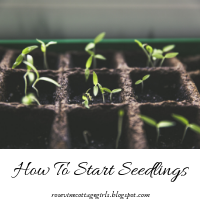Spring is here, which means the gardening season is upon so we thought we'd share how to transplant your seedlings into the garden! It doesn't matter if you are planting in the ground or using raised beds like us, we're going to teach you how to give your plants a chance to thrive.
Gardening can be really intimidating, especially to those who are new at it but we have a secret for you! Transplanting is super easy!
Before You Transplant
- Check frost dates for your area
- Check the conditions each of the plants you plan to transplant need to thrive.
- Keep an eye on your local forecast if you are expecting a cold snap hold off until weather is more favorable.
- If you started your plants from seeds try keeping a garden journal with the date you planted the seeds and the date you transplant them, this can help you next year when you go to plant.
Preparing Your Plants & Garden
- Harden off your plants before moving them to the garden, to do this leave your plants outside starting for several hours and then leave them out longer and longer. Make sure you start off in a sheltered, mostly shady place that is protected from the wind. Slowly bring them into more and more sunlight and expose them to more windy conditions. Make sure you keep the soil nice and moist while you are hardening off your plants.
- Don't water your plants as much this week and withhold fertilizer so they will get used to garden conditions
- If you are planting in raised beds make sure the weeds are pulled before planting, if you are putting them in the ground you may need to till and add fertilizer or manure to your soil to help your plants thrive in their new home.
Time To Plant
- If at all possible transplant your seedlings on an overcast day, or early morning hours this way they have some time to adjust before being exposed to the intense midday sun.
- Dig a hole large enough to comfortably hold the roots of the plant, push the soil back covering the roots. Label where you planted each plant if you are keeping a garden journal you may want to sketch your garden and where everything is planted.
- Water the soil around the seedlings after transplanting, but be careful not to damage the plants.
- Fertilize every couple days using a boxed fertilizer or compost tea (use a big bucket and place some manure at the bottom, fill the rest with water allow to sit for several hours. Use this to water your plants)
- Watch for late spring frosts in your forecast. You can cover your plants with sheets or build a cold frame around them, you can also run Christmas lights between your plants to keep them warmer.







No comments:
Post a Comment
Note: Only a member of this blog may post a comment.